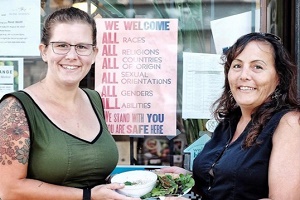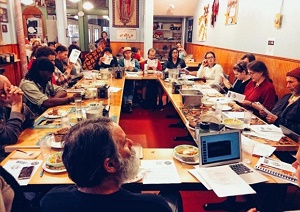
 Special to the Philanthropy Journal
Special to the Philanthropy Journal
By Dominique Jones and Chris Gambino
As a land-grant university, NC State is committed to providing students hands-on, highly-engaged learning opportunities AND to providing research that is of direct, practical use to the fields we work in. Philanthropy Journal proudly presents the latest in a series of evidence-based resource articles developed by Dr. Amanda J. Stewart‘s masters level Management of Nonprofit Organizations classes. These articles represent a perfect overlap of engaged learning and practical research.
Most of us in the sector, 35.5% according to Urban Institute’s The Nonprofit Sector in Brief 2015, exist to respond to the growing needs of underserved communities. And for all the compassion we have for others, the sector is still a revolving door. Turnover statistics aside, our ability to pay a living wage and provide full health benefits is more important to our missions than we may think.
 As a sector, we provide products and services that the private and public sectors either cannot or choose not to provide. Some of those provisions are necessities like food, housing, healthcare, and education. Public assistance, through government programs, is only available to individuals and families when their income is under a certain poverty threshold. That threshold calculation is still based on how the U.S. defined poverty in 1963. In 1963, 30% of the “average” American income was spent on food. Today, it fluctuates around 10% (USDA Economic Research Service), meaning families are often left to meet the rising cost of housing, healthcare, and education on their own.
As a sector, we provide products and services that the private and public sectors either cannot or choose not to provide. Some of those provisions are necessities like food, housing, healthcare, and education. Public assistance, through government programs, is only available to individuals and families when their income is under a certain poverty threshold. That threshold calculation is still based on how the U.S. defined poverty in 1963. In 1963, 30% of the “average” American income was spent on food. Today, it fluctuates around 10% (USDA Economic Research Service), meaning families are often left to meet the rising cost of housing, healthcare, and education on their own.
The table below provides the current poverty-threshold of income levels designated by that the U.S. Federal government. To help with context, the current federal minimum wage is $7.25 per hour, and has not changed since 2009. Intuitively, if not from experience, a family of three cannot sustain a healthy and productive life on $19,173 a year. Which is why defining our employees’ wages based on food is not livable.

Table 1. U.S. Poverty Threshold for 2017 by Size of Family and Number of Related Children Under 18 Years (Click to enlarge)
After looking at several ideas and technical definitions of living wage, the most encompassing definition is:
“a livable wage ensures workers can cover the cost of food, housing, healthcare, childcare, transportation, clothing, education, and savings for themselves and their families.”
If the mission statement of your organization deals with any one of these aspects of the living wage definition, then living wage is your mission. Furthermore, the reason organizations in our sector are tax exempt is so that we can reinvest our profits into our mission. A failure to make that investment into our employees is in opposition of our tax-exempt status and actually perpetuates the vicious cycle of poverty.
One organization that is actively focused on getting people out of poverty and is successfully paying their employees a living wage is Sisters Of The Road (SOTR), a nonprofit café. SOTR exists to build authentic relationships and alleviate the hunger of isolation in an atmosphere of nonviolence and gentle personalism that nurtures the whole individual, while seeking systemic solutions that reach the roots of homelessness and poverty to end them forever. Extending their mission inward, they prioritize hiring individuals from their community, increasing organizational mobility, facilitating collective staff-community decision making, and equity throughout the organization. Acknowledging the high-level of needs among the homeless community, SOTR allows flexible work schedules to balance the emotional and physical demands of the work environment.
Here are three ways they are demonstrating mission-driven practices within their organizational policies and procedures:
 Employee retention is mission-driven. If your organization’s theory of change is built on relationships, turnover is your biggest barrier to being effective. Every year that an organization is reluctant to prioritize paying a livable wage, it resets relationships with its community of service recipients and donors, because of staff turnover. Most often it is direct service staff, but can be volunteer coordinators and development personnel, which are all critical person-to-person roles needed to advance a mission (Nonprofit HR, 2017). As Betsy Glickman, Finance Manager at SOTR, says, “stability is key in this community.” She adds, we “want stable employees so that they can be stability for our community members.” To ensure that stability, at SOTR, all full-time staff start at $16.30 per hour; >$4 more than the state’s minimum wage.
Employee retention is mission-driven. If your organization’s theory of change is built on relationships, turnover is your biggest barrier to being effective. Every year that an organization is reluctant to prioritize paying a livable wage, it resets relationships with its community of service recipients and donors, because of staff turnover. Most often it is direct service staff, but can be volunteer coordinators and development personnel, which are all critical person-to-person roles needed to advance a mission (Nonprofit HR, 2017). As Betsy Glickman, Finance Manager at SOTR, says, “stability is key in this community.” She adds, we “want stable employees so that they can be stability for our community members.” To ensure that stability, at SOTR, all full-time staff start at $16.30 per hour; >$4 more than the state’s minimum wage.
Equitable pay is mission-driven. To achieve equitable pay, SOTR transitioned back to hourly compensation to reduce the pay inequity within their organization. Glickman says, “the salary model leads to overwork and burnout.” Providing livable wages at an hourly rate enables staff to focus on the organization’s mission while achieving a healthy work-life balance.
Hiring from within is mission-driven. SOTR intentionally employs individuals from the community in which they serve. Within the café, individuals are extended the opportunity to continue to gain successful employment as on-call staff member and entry-level staff. SOTR, tries to provide on-call staff, 10 hours of work per week, starting at $15 per hour. Entry-level staff are guaranteed 16 hours of work per week and start at $15.50 per hour. All employees that work 20 hours or more a week are considered full-time and receive health insurance coverage and paid vacation. Both full-time and entry-level staff are paid sick leave, holiday pay, and civil disobedience leave.
Getting on the Road to Paying Livable Wages
 Navigating human resource policies and procedures to achieve paying a livable wage does not happen overnight, or in vacuum. SOTR was not able to implement all these changes without establishing organizational and board buy-in. The organization utilized internal staff champions, strategic planning, and effective communication to align their mission both internally and externally. Those champions were both top-down and bottom-up staff members. To this day, leadership at SOTR prioritizes fundraising and operational decisions to ensure that they are effectively fulfilling the mission of the organization and making sure that staff do not have to worry about illness or looking for another job because of finances.
Navigating human resource policies and procedures to achieve paying a livable wage does not happen overnight, or in vacuum. SOTR was not able to implement all these changes without establishing organizational and board buy-in. The organization utilized internal staff champions, strategic planning, and effective communication to align their mission both internally and externally. Those champions were both top-down and bottom-up staff members. To this day, leadership at SOTR prioritizes fundraising and operational decisions to ensure that they are effectively fulfilling the mission of the organization and making sure that staff do not have to worry about illness or looking for another job because of finances.
Considering the following can get your organization on the road to paying livable wages:
- Educate Yourself. Various nonprofit organizations and governmental agencies are adopting livable wage policies. Check out the living wage calculator.
- Be the Game Changer. Develop a formal committee or task force of staff representing different roles, wages and experiences within the organization to discuss the increased fundraising needed to bring all employees to a living wage.
- Embrace Critical Conversations. Change is not easy. Instead of focusing on winning the discussion, embrace having progressive conversations that establish organizational strategies to move towards livable wages. Check out Partnership for Working Families Policy & Tools: Living Wage resources.
Lastly, within the sector we can become so focused on serving our various communities that we forget the people passionate about the mission also need to be able to afford access to affordable health benefits, basic necessities, and stable housing for their families. Knowing that an organization like SOTR is thriving while providing living wages and full health benefits should be inspiring.
Dominique Jones is a North Carolina State University, Masters of Public Administration (MPA) program Spring 2018 graduate. She is committed to promoting equity and reducing disparities among underserved individuals and communities through program development, collaborative partnerships and public policy.
Chris Gambino lives and works in Raleigh, NC. He is focused on catalyzing innovative solutions to complex socio-ecological issues through identifying points of consensus among diverse stakeholders.




